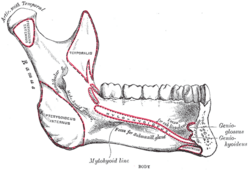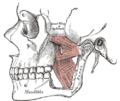Mandible facts for kids
| Bone: Mandible | ||
|---|---|---|
| Mandible. Outer surface. Side view | ||
| Mandible. Inner surface. Side view | ||
| Latin | mandibula | |
| Gray's | subject #44 172 | |
| Precursor | 1st branchial arch | |
| MeSH | Mandible | |
The mandible is a very important bone in your face! It's also known as your jawbone or dentary. This bone holds your lower teeth and helps you chew food, talk, and make different facial expressions. It's the largest and strongest bone in your face. The word "mandible" comes from the Latin word mandibula.
Contents
Your Amazing Jawbone: The Mandible
What is the Mandible?
The mandible is the only bone in your head that can move a lot. It forms the lower part of your jaw. It connects to your skull near your ears. This connection lets your mouth open and close.
The mandible is a single bone in humans and other mammals. It's super strong because it has to handle all the chewing forces. Think about how much work your jaw does every day!
How the Jawbone Changed Over Time
Did you know that the jawbone has changed a lot through evolution? In ancient bony fish, the lower jaw was made of many different bones. Over millions of years, as animals evolved, these bones slowly became fewer.
In humans and other mammals, most of these smaller bones disappeared. Some of them even turned into something completely different! For example, some bones that used to be part of the lower jaw in early mammals actually became the tiny bones inside your ear. These are called ear ossicles. They help you hear! This is a cool example of how evolution can reuse parts for new purposes.
Parts of the Mandible
Your jawbone isn't just one simple piece. It has several important parts:
- Body: This is the main, curved, horizontal part of the jawbone. It holds your lower teeth.
- Ramus: These are two flat, vertical parts that extend upwards from the back of the body. They connect your jaw to your skull.
- Condyle: At the top of each ramus is a rounded part called the condyle. These condyles fit into a special socket in your skull. This forms the temporomandibular joint (TMJ), which is like a hinge for your jaw.
- Coronoid Process: This is a pointed part also at the top of each ramus, in front of the condyle. Muscles that help you chew attach here.
- Alveolar Process: This is the part of the jawbone that contains the sockets for your teeth.
Why is the Mandible So Important?
The mandible is essential for many daily activities:
- Eating: It allows you to bite, chew, and grind your food. Without it, eating would be impossible!
- Speaking: The movement of your jaw helps you form different sounds and words.
- Facial Expressions: Your jaw movements contribute to many facial expressions, like smiling or frowning.
- Protecting Teeth: It provides a strong foundation for your lower teeth, keeping them safe and in place.
Images for kids
-
A panoramic radiograph reveals the mandible, including the heads and necks of the mandibular condyles, the coronoid processes of the mandible, as well as the nasal antrum and the maxillary sinuses.
See also
 In Spanish: Mandíbula para niños
In Spanish: Mandíbula para niños



















